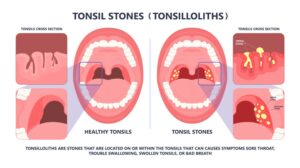You’ve brushed, flossed, rinsed, and popped mints like candy but the funky breath lingers. The culprit might be something you may never even heard of: tonsil stones. Professor Dato’ Dr Balwant Singh Gendeh clears the air on this matter.
WORDS LIM TECK CHOON
 FEATURED EXPERT FEATURED EXPERTPROFESSOR DATO’ DR BALWANT SINGH GENDEH Senior Consultant Ear, Nose, and Throat (ENT) Surgeon Pantai Hospital Kuala Lumpur |
WHAT’S AT THE BACK OF YOUR THROAT?
To understand tonsil stones, we need to start by looking at the tonsils.
- Professor Dato’ Dr Balwant Singh Gendeh explains that our tonsils are small lumps of tissue at the back of our throat are part of your immune system.
- More specifically, they are lymphoid organs that help trap and filter out bacteria and viruses that enter through our mouth and nose.
Tonsils Are Not Smooth Organs
They are riddled with natural crevices called crypts.
- These crypts form pockets or folds in the tonsils.
- In children, these crypts are especially important because they are linked to lymph nodes.
- Germs that find their way into these crypts are, therefore, funnelled to these lymph nodes and help prime the immune system by exposing it to these germs.
- Therefore, these crypts help a child’s still developing immune system to recognize these germs as helpful and prepare the immune system to destroy these germs in the future.
However, the Crypts Also Present a Potential Problem
- These crypts do not just collect bacteria.
- They can also trap food debris, dead cells, and mucus.
- Professor Dr Balwant tells us that when all these substances build up in the crypts, they can harden into tiny, smelly lumps called tonsil stones or tonsilloliths.
TONSIL STONES: A SMELLY PROBLEM

Tonsil stones are often a reason behind persistent bad breath, especially when nothing else seems to explain it.
“This is because the bacteria in the tonsil stones produce volatile sulphur compounds that smell like rotten eggs,” says Professor Dr Balwant.
Other Signs that You May Have Tonsil Stones
Tonsil stones can be seen as white or yellowish lumps in the tonsils.
However, not all tonsil stones are visible. Other tell-tale signs include:
- The sensation of something “stuck” at the back of your mouth
- Difficulties in swallowing
- A chronic or long-term sore throat
WHAT CAN YOU DO ABOUT TONSIL STONES?
According to Professor Dr Balwant Singh Gendeh, there is a simple home remedy we can try: gargle with warm salt water a few times every day, especially after meals.
“This can help dislodge the tonsil stones,” he says.
The saltwater gargles can also help soothe any soreness or irritation in the throat.
| You may be tempted to try to physically remove the tonsil stones with a toothpick or needle, especially if they are large and visible. This is not a good idea, as you can end up injuring the tender tonsil tissues and causing an infection! |
WHEN SHOULD YOU SEE A DOCTOR?
- If tonsil stones occur often. Frequent or large stones may point to chronic tonsillitis or deeply pitted tonsils.
- If you experience persistent symptoms such as a sore throat, difficulty swallowing, a constant “something’s stuck” sensation, or bad breath that won’t quit no matter what.
- If your tonsils show signs of infection such as redness, swelling, or pus, or if you have fever and feel generally unwell.
- If your quality of life is affected, such as your bad breath is making it embarrassing for you to interact with other people at work or at home.
For persistent troublesome cases or for tonsil stones that keep coming back, Professor Dr Balwant reveals that the doctor would usually recommend a tonsillectomy or surgical removal of these tonsils.
| This article is part of our series on health issues related to our ears, nose, and throat. |














